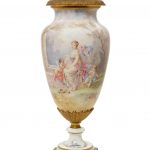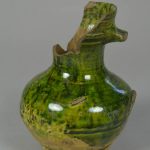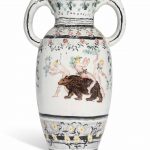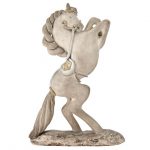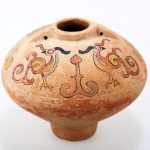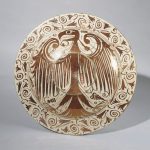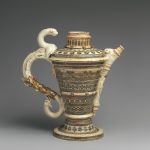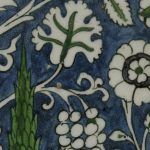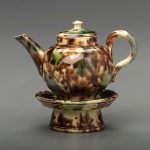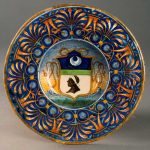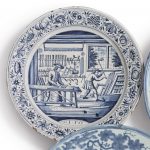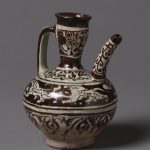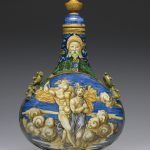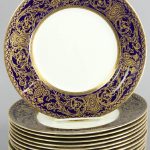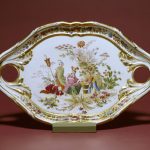Information and gallery of earthenware. Earthenware, pottery that has not been fired to the point of vitrification and is thus slightly porous and coarser than stoneware and porcelain. The body can be covered completely or decorated with slip (a liquid clay mixture applied before firing), or it can be glazed. For both practical and decorative reasons, earthenware is usually glazed. To overcome its porosity (which makes it impracticable for storing liquids in its unglazed state, for example), the fired object is covered with finely ground glass powder suspended in water and is then fired a second time. During the firing, the fine particles covering the surface fuse into an amorphous, glasslike layer, sealing the pores of the clay body. There are two main types of glazed earthenware. One is covered with a transparent lead glaze; when the earthenware body to which this glaze is applied has a cream colour, the product is called creamware. The second type, covered with an opaque white tin glaze, is variously called tin-enameled, or tin-glazed, earthenware, majolica, faience, or delft. Reference: Encyclopaedia Britannica
A Sèvres style gilt bronze mounted earthenware covered urn late 19th century height 29in (73.5cm)
Sold for US$ 2,000 (£ 1,536) inc. premium at Bonhams in 2018
17th century earthenware drinking jug, buff and green-glazed. Possibly Beauvais Earthenware or Border ware.
Reference: © The Trustees of the British Museum
Jean Puy (1876-1960) Les faunesses signed and inscribed ‘J Puy Les Faunesses’ (on the neck); signed and dated ‘JPuy 1907’ and with Metthey’s monogram (underneath) tin-glazed earthenware vase Height: 13 7/8 in. (35.3 cm.) Executed in 1907
Sold for GBP 2,500 at Christie’s in 2018
Colette Gueden for Atelier Primavera Art Deco Painted Earthenware Figure of a Rearing Horse Signed PRIMAVERA MADE IN FRANCE Height 15 1/4 inches.
appears to be in generally good condition with the following noteworthy exceptions/condition issues: (1) there is a loss to the applied reign on one side of the horse’s head (visible in a comparison of the photos) that otherwise would go from ring to ring; (2) there has been a poor repair to a previous detachment break at the uppermost portion of the horse’s head where there is a yellow horizontal ring and braided mane; the top side of the naturalistic base is soiled and has a mottled appearance (perhaps it was originally painted or slip decorated in white); the yellow saddle appears to have areas of paint flaking/loss; the horse has an overall dulled/soiled appearance, consistent with age and handling; there are some small shallow flake losses to the bottom rim area, not of any real significance; not blacklighted
Sold for $1,000 (includes buyer’s premium) at Doyle New York in 2018
A JIN DYNASTY STYLE COLOR EARTHENWARE JAR WITH FOUR PHOENIX. C293. China, JIN dynasty style. C Property from a Private American New York City Collection. Measure: Height 4.5″,diameter 5.5″. CONDITION: Good, no significant damage or repairs observed.
Sold for $600 at Metropolitan Auction of Art , Inc. in 2018
Serving dish bearing the coat of arms of the Gondi family of Florence
The bowl is decorated with the coat of arms of the Gondi family of Florence in the center, ringed by a concentric pattern of fine gilded vine leaves covering the entire white ground. The style of decor and the technique used indicate this item is an example of the celebrated Hispano-Moorish pottery tradition. Lustered earthenware imitates metal tableware and was inspired by an old Islamic tradition that spread from the Middle East to the whole of the Mediterranean basin.
Reference:The Louvre
This ewer is one of the largest and most impressive examples of a low-fire white pottery made in France in the middle years of the sixteenth century. Known as Saint-Porchaire ware, this group of elaborate and often architectural pieces is distinguished by the complex interlace designs of colored clays inlaid into the cream-colored earthenware body. These wares were believed to have been produced in the town of Saint-Porchaire in western France, but a Paris origin has also been suggested due to their technical sophistication and the ambition of their designs.
Reference: The Metropolitan Museum of Art
Rectangular fragment of an Islamic earthenware tile. One side is glazed and decorated with green and white floral motifs against a blue background. The underside is coarse and unglazed and there is some chipping to the edges.
Reference: Museum of Applied Art and Sciences
Miniature teapot stand English about 1750 Made at Whieldon Factory (England)
Tazza-shaped with wide foot; lead-glazed earthenware in mottled brown, green, and blue. Unmarked. Condition: good.
Reference: Museum of Fine Arts Boston
Broad-rimmed bowl with palmette and cornucopia border; in the center, shield of arms of the Saracinelli of Orvieto
Earthenware, covered front and back with a white tin glaze of slightly pinkish tone. The painting is in blue, green, yellow, brown, and white, with golden and reddish luster. There are four kiln-spur marks on the front near the edge, and a kiln scar on the back. The inner and outer edges of the rim are chipped, and there is some scratching of the glaze.
Reference: National Gallery of Art
Frisian tin-glazed earthenware blue and white charger 1769 Painted in the center with two carpenters at work, within a meandering floral border, inscribed and dated 17 í : F 69. Diameter: 12 1/2 in. 30.5 cm
Sold for 6,250 USD at Sotheby’s in 2018
13th century Iranian ewer of earthenware. With a spout and handle. Decorated with a frieze of leopards in lustre.
Reference: © Victoria and Albert Museum
“Pilgrim Flask” with Mercury and Psyche
This is one of the earliest signed and dated works by Francesco Xanto Avelli, one of the most original painters of maiolica (tin-glazed earthenware) and the only one who frequently signed his works. He aspired to the humanist culture of his patrons and his subject matter reflects some level of familiarity with poetry and classical literature. Indeed, several of his plates illustrate his own poems. He often depicted little-known scenes from ancient history, which he sometimes identified on the back of the plate. Like other painters of istoriato ware (decorated with stories), Xanto Avelli frequently relied on prints for compositional models. Many of those prints are after works by Raphael whose classicizing figures provided Xanto Avelli with a handsome visual vocabulary.
Reference: The Walters Art Museum
